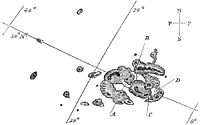
Solar cycle 10
Encyclopedia

Solar cycle
The solar cycle, or the solar magnetic activity cycle, is a periodic change in the amount of irradiation from the Sun that is experienced on Earth. It has a period of about 11 years, and is one component of solar variation, the other being aperiodic fluctuations. Solar variation causes changes in...
since 1755, when recording of solar sunspot
Sunspot
Sunspots are temporary phenomena on the photosphere of the Sun that appear visibly as dark spots compared to surrounding regions. They are caused by intense magnetic activity, which inhibits convection by an effect comparable to the eddy current brake, forming areas of reduced surface temperature....
activity began. The solar cycle lasted 11.3 years, beginning in December 1855 and ending in March 1867. The maximum smoothed sunspot number (monthly number of sunspots averaged over a twelve month period) observed during the solar cycle was 97.3, and the minimum was 5.2. There were a total of approximately 406 days with no sunspots during this cycle.
Solar storm of 1859

Geomagnetic storm
A geomagnetic storm is a temporary disturbance of the Earth's magnetosphere caused by a disturbance in the interplanetary medium. A geomagnetic storm is a major component of space weather and provides the input for many other components of space weather...
on Earth occurred, known as the Carrington Event. Aurorae
Aurora (astronomy)
An aurora is a natural light display in the sky particularly in the high latitude regions, caused by the collision of energetic charged particles with atoms in the high altitude atmosphere...
were seen around the world, most notably over the Caribbean
Caribbean
The Caribbean is a crescent-shaped group of islands more than 2,000 miles long separating the Gulf of Mexico and the Caribbean Sea, to the west and south, from the Atlantic Ocean, to the east and north...
; also noteworthy were those over the Rocky Mountains
Rocky Mountains
The Rocky Mountains are a major mountain range in western North America. The Rocky Mountains stretch more than from the northernmost part of British Columbia, in western Canada, to New Mexico, in the southwestern United States...
that were so bright that their glow awoke gold miners, who began preparing breakfast because they thought it was morning.
Telegraph systems all over Europe and North America failed. Telegraph pylons threw sparks and telegraph paper spontaneously caught fire. Some telegraph systems appeared to continue to send and receive messages despite having been disconnected from their power supplies.
From August 28, 1859 until September 2, numerous sunspots and solar flare
Solar flare
A solar flare is a sudden brightening observed over the Sun surface or the solar limb, which is interpreted as a large energy release of up to 6 × 1025 joules of energy . The flare ejects clouds of electrons, ions, and atoms through the corona into space. These clouds typically reach Earth a day...
s were observed on the sun. Just before noon on September 1, the British astronomer Richard Carrington observed the largest flare, which caused a massive coronal mass ejection
Coronal mass ejection
A coronal mass ejection is a massive burst of solar wind, other light isotope plasma, and magnetic fields rising above the solar corona or being released into space....
(CME) to travel directly toward Earth, taking 18 hours. This is remarkable because such a journey normally takes three to four days. It moved so quickly because an earlier CME had cleared its way.

